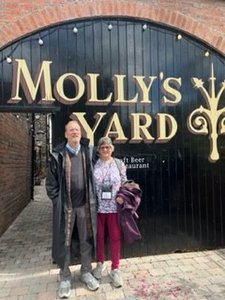Advertisement

 Lunch break
Lunch break
Neat little place near Queens UniversityStarted in earnest the next morning (Friday) with an illustrated talk on Conflict and Murals in Northern Ireland by Bill Rolston. Very good speaker. Helped clarify a number of terms and groups for most of us. Main point: Ireland was conquered and colonized beginning in 1152 with the Anglo Normans. They built castles in eastern Ireland (the Castles of Ireland series on Netflix did a good job of this); these castles were considered “the pale”. Everything outside (The Irish) were “beyond the pale”. End of 1600s, end of Elizabeth I’s reign, Ulster was the center of resistance to the English. This prompted me to ask our wonderful tour leader, James Monaghan, about ”Ulster”. I kept hearing the place name but it’s not a county of town. There were four provinces of Ireland; Ulster was one of the four. In her last two years, Elizabeth tried to pacify Ulster. That didn't work so they sent in settlers, mainly Presbyterians from Scotland. The three tiers were: English Anglicans, Scots Presbyterians, and Irish Catholics. The religious label, not theology, has been the division ever since.
In the 1640s uprising against Oliver Cromwell, 1/4 to 1/3 of the people were killed.To this day, Oliver
Cromwell is hated. In the late 1600s, James has a son, who is Catholic. William of Orange was invited to be king of England. He won several battles in Ireland to cement that throne; King Billy is still celebrated on July 11-12. In the 1800s, the Orangemen were founded to commemorate King Billy's victory. Parades continue annually. After his victory, a series of penal laws were instituted against Catholics: own no land, no civil rights, etc.
In 1908, Orangemen started moving their flags to building murals, usually William of Orange on his horse winning the battle.
1914: Home Rule Bill passed (partly because of a Rule change saying that if something had passed twice but been blocked by the House of Lords that it could not be blocked a third time). Protestants opposed the bill and, with the outbreak of WWI, their military units joined the English army, lots of them serving at Gallipoli and the Somme.
1922: Partition
1949: Republic of Ireland and Northern Ireland. the North was a consolidation of Protestant strength; Catholics were 'sold out', never wanted this. Specific counties were included (not all of Ulster) to guarantee a Protestant majority in perpetuity.
1960s: civil rights movement, as in U.S., and amongst Catholics in Northern Ireland. Unionist monolith had a problem: they were split into four unionist parties. Murals moved from historic themes to military themes, armed men, offensive warnings, lots of balaclavas and guns. Occasionally history, WWI, Oliver Cromwell, Siege of Derry, King Billy.
Millions of Ulster Scots (Scotch Irish) migrated to the U.S.
Nationals didn't paint for a while. Catholics had a vibrant culture but away from Unionist eyes. Couldn't get away with painting.
early 1970s: the Hunger Strikes: The unionist parties controlled the jails, attempted to treat political offenders as regular criminals. The Catholics maintained they were not criminals, they were political offenders and regular people--activists. Escalated till the Hunger Strikes. In 1981, ten men died. Thatcher was PM; three days later, she gave in. Huge campaign, demonstrations, and young people started painting murals. The "British Solution" to Ireland was compared to Sisyphis.
Sinn Fein is the political wing of IRA.
1998: no more armed people in murals except in memorials, myth, international. Even Che Guevara's granny was Irish. There is a bill in British Parliament effectively giving amnesty to all participants of the
Troubles which is not supported by everyone (forgive my son, not the many who killed my cousin...). Loyalists now paint a lot about WWI, the Queen, occasionally there are new sinister men.
Question about church attendance: attendance is down all over; Catholic attendance is down, mainly because of the abuses.
Then, visited Belfast's City Hall for a docent-led tour. Big building with lots of portraits of past Lord Mayors. Some beautiful stained glass windows throughout. Even a wedding going on!
After lunch, riding the renowned Black Taxis, we rode to see the colorful and evocative murals of West Belfast with commentary by these local expert taxi drivers, stopping at some to hear further explanations.
The city is actually divided by fences, big fences. All the Protestants live on one side, all the Catholics on the other in a gated, with gates that lock at 6:30 p.m. (except one central one). People work together but schools are either protestant or catholic.
The "Peace Wall" is a 45 foot steel and wire wall built by the British just behind the Catholic section of time. Then gates were put up at the ends of the row houses to
keep kids from climbing in and throwing bombs over the fence.
Pretty depressing afternoon so we went to the Titanic Hotel for dinner....originally the headquarters of Harlan & Wolff, builders of the Titanic and its sister ships. The beautiful, open, light-filled room used for drafting and drawing is now a lovely bar/lounge. The dinner speaker delivered a talk on the history of industry in Belfast: ship building, rope making, and linen making. The linen factories replaced what had been a cottage industry at home, prompting the move from country to city of many women; the factories were very successful but forced a population redistribution. Belfast ship builders also began having the parts for the machinery in the factories made in Belfast, feeding another line of employment.
Advertisement
Tot: 0.286s; Tpl: 0.013s; cc: 12; qc: 59; dbt: 0.1829s; 1; m:domysql w:travelblog (10.17.0.13); sld: 1;
; mem: 1.2mb























